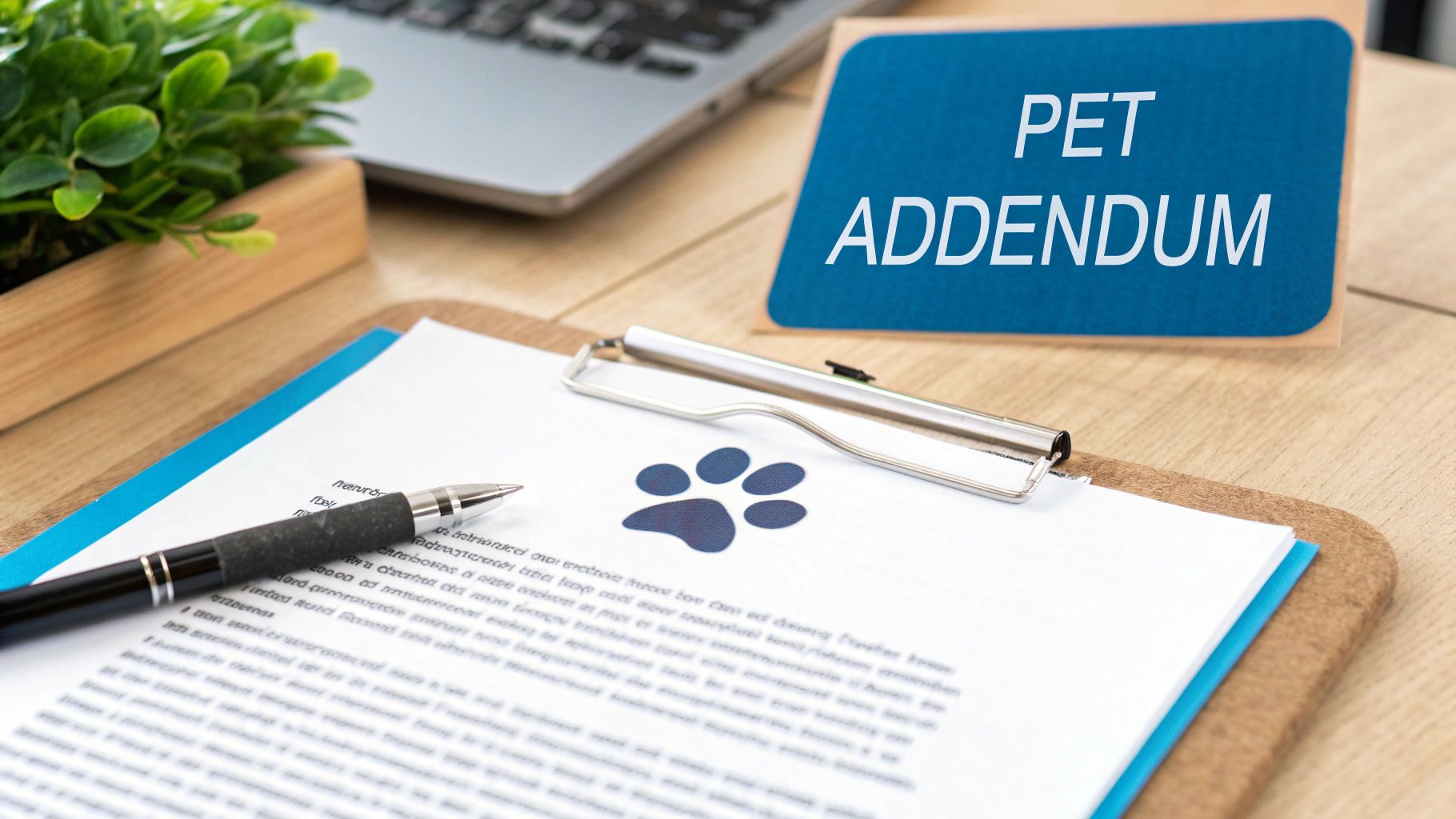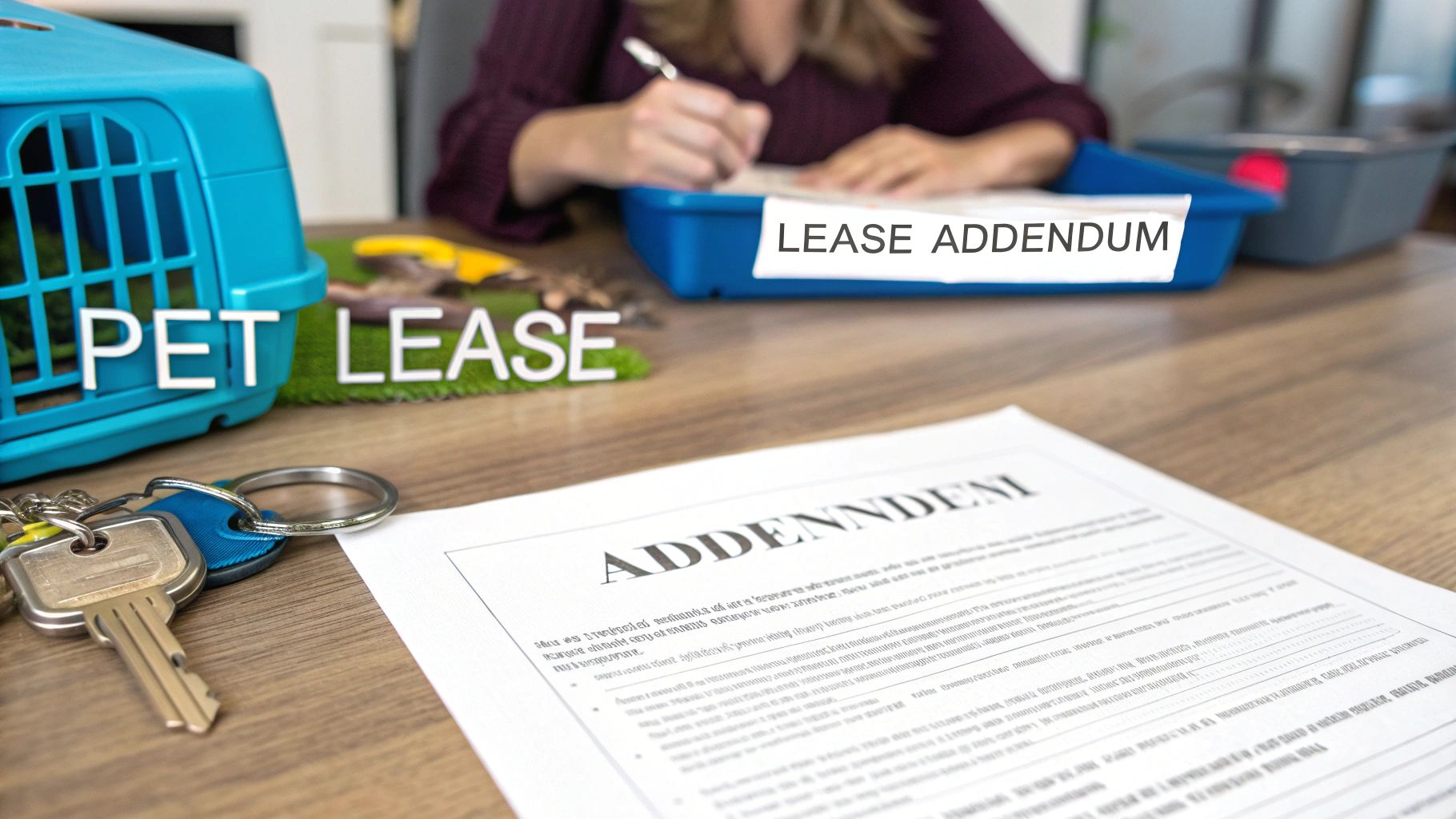A lease addendum for pets is more than just a piece of paper; it’s a detailed, legally binding document attached to the primary lease agreement that acts as a critical operational tool. For property managers overseeing large portfolios, it's the standardized rulebook for tenants with pets, providing essential protection, clarity, and a framework for revenue generation. A generic "pets allowed" clause is a liability; a detailed addendum is a strategic asset.
Why a Standard Pet Clause No Longer Works

In large-scale property management, every day a unit sits vacant directly erodes net operating income. When vacancy rates creep up, a common reaction is to tighten rules, but a blanket "no pets" policy is a significant operational misstep in today's market. What was once a minor lease detail now requires a sophisticated, data-driven approach to maintain a competitive edge.
The reality is that pet ownership has exploded. Approximately 70% of US households now own a pet, a figure that continues to climb. This demographic shift transforms pet-friendly rentals from a simple amenity into a powerful revenue driver and a key lever for reducing Days on Market (DOM). A generic, one-sentence pet clause buried in a lease is insufficient for managing risk or capitalizing on this massive market demand.
The Financial Impact on Large Portfolios
For portfolios managing hundreds or thousands of doors, the metrics are clear. Properties that welcome pets consistently experience a significant reduction in their Days on Market (DOM). By opening your units to a much larger pool of qualified renters, you accelerate the lead-to-lease timeline, which has a direct, positive impact on your net operating income. For example, if a unit rents for $2,000/month (~$67/day), reducing DOM by just 10 days across 100 vacant units translates to $67,000 in recovered revenue.
A well-architected lease addendum for pets becomes an essential tool in your operational arsenal. It’s no longer just a permission slip. Instead, it’s a scalable framework for:
- Mitigating Risk: Clearly define tenant responsibilities for damages, noise, and waste cleanup, eliminating ambiguity and standardizing enforcement across your portfolio.
- Generating Ancillary Revenue: Structure non-refundable pet fees and monthly pet rent to boost revenue-per-door, turning a potential cost center into a reliable profit center.
- Improving Tenant Quality and Retention: Responsible pet owners often prove to be stable, long-term residents. They are typically willing to pay a premium for a home that accommodates their entire family, leading to lower turnover costs.
The objective isn't merely to allow pets—it's to manage them effectively with a detailed, enforceable addendum. This strategy converts a potential liability into a measurable asset that enhances portfolio performance.
This is about optimizing asset performance at scale. As you analyze your portfolio's KPIs, consider the revenue lost by excluding a significant portion of the rental market. A robust pet addendum is the key to unlocking that potential while protecting your properties. To see a full financial breakdown, explore our guide on why you should allow pets.
Building an Ironclad Pet Addendum From Scratch

A vague or generic lease addendum for pets is an operational vulnerability. For property managers handling hundreds of units, ambiguity creates disputes, inconsistencies, and financial loss. Your addendum must be a precise, enforceable document that leaves zero room for interpretation, protecting your assets and setting clear expectations for tenants from day one.
Moving beyond a basic template is non-negotiable for managing properties at scale. Each clause must serve a strategic purpose and be easily enforceable by your team. To build a document that functions as an effective risk management tool, you must avoid common mistakes in contracting that could weaken its legal standing. This isn't just a list of rules; it's a system designed to minimize risk across your entire portfolio.
Detailing the Pet and Tenant Responsibilities
The foundation of a strong addendum is specificity. Don't just approve "one dog"—obtain comprehensive identification for every animal.
- Full Identification: Mandate the pet's name, breed, age, weight, and color.
- Visual Confirmation: Require a clear, current photo of the pet for the tenant's file. This simple step prevents tenants from swapping an approved pet for an unapproved one mid-lease.
- Health and Licensing: Obtain proof of current vaccinations (especially rabies) and any local licensing or registration. Copies should be on file before the lease is signed.
This level of detail creates an undeniable record, preempting disputes. It also establishes a standard of responsible pet ownership, helping to attract high-quality tenants.
Establishing Clear Rules of Conduct
Once the pet is identified, define the exact expectations for the tenant and their animal. Vague instructions like "tenants must clean up after their pet" are nearly impossible to enforce consistently. You need explicit, actionable rules that your team can manage without guesswork.
An ironclad addendum doesn't just list prohibitions; it outlines the exact consequences for non-compliance. This transforms the document from a set of suggestions into an enforceable operational tool.
For instance, instead of a general cleanup rule, your addendum should state that waste must be picked up immediately and disposed of in designated areas. Back this up with a clear fine structure—perhaps a $50 fine for the first offense, with escalating penalties for subsequent incidents. This creates a measurable system for enforcement that can be applied to noise, common area use, and property damage.
To help you get started, here’s a breakdown of the clauses every scalable pet addendum should include.
Essential Clauses for Your Pet Lease Addendum
This table outlines the critical clauses, their purpose, and the details needed to make them effective and enforceable across a large portfolio.
This structured approach transforms your addendum from a legal formality into a practical management tool. By using digital condition reports and property checks, you can create an indisputable record of property conditions before and after a pet moves in, which integrates seamlessly into your leasing workflow and accurately assesses damages against the tenant’s deposit.
How to Structure Pet Fees for Maximum ROI

For property managers operating at scale, a lease addendum for pets is more than a risk mitigation tool—it's a significant revenue opportunity. The objective is not merely to cover potential damages but to actively boost your portfolio's net operating income, turning every pet-friendly unit into a higher-performing asset.
The key is to move beyond a simplistic, one-size-fits-all deposit. A layered fee structure allows you to capture different revenue streams while addressing the financial realities of pet occupancy. By strategically combining fees, deposits, and pet rent, you create a system that is both profitable for your owners and clear for responsible, high-quality tenants.
This strategy is supported by powerful market trends. The global pet economy is projected to surpass $500 billion by 2030, signaling a deep, sustained demand for pet-friendly housing. Formalizing your policies and optimizing fees is a sound business decision. You can read more about the growth of the pet economy on petfoodindustry.com.
Differentiating Your Fee Structure
To maximize your return on investment (ROI), it's crucial to understand the distinct function of each charge. Each component addresses a different financial aspect of allowing a pet on the property.
One-Time, Non-Refundable Pet Fee: This fee covers the administrative cost of approving a pet, including time spent verifying vet records, updating lease documents, and managing pet-specific data. It is not tied to damages and is earned upon signing the addendum.
Refundable Pet Deposit: This functions like a standard security deposit but is specifically allocated for pet-related damages, such as repairing scratched floors, replacing soiled carpets, or treating odors. Separating it from the main security deposit simplifies accounting at move-out.
Recurring Monthly Pet Rent: This generates consistent, predictable income. Pet rent compensates for the cumulative wear and tear a pet causes over time—minor depreciation that doesn't qualify as "damage" but still affects a unit's condition.
By layering these three components, you create a comprehensive financial shield. The fee covers operational costs, the deposit protects against specific damages, and the monthly rent boosts ongoing cash flow.
A Framework for Setting Profitable and Competitive Rates
Determining the right price point is a strategic balance between maximizing revenue and attracting top-tier tenants. This strategy should be driven by data, not intuition.
1. Conduct a Local Market Analysis
Begin by analyzing what other large-scale operators in your market are charging. Establish a baseline for pet fees, deposits, and monthly rent. If your properties offer superior amenities or a more accommodating pet policy, position your rates at or slightly above the market average.
2. Segment by Property and Pet Type
A single flat fee across a diverse portfolio is inefficient and leaves revenue on the table. Tier your pricing based on factors that reflect actual risk.
- Property Characteristics: A unit with new hardwood floors warrants a higher pet deposit than one with durable laminate flooring. A single-family home with a fenced yard might command higher pet rent than a small apartment.
- Pet Size and Weight: It is standard practice to charge more for larger animals, as they have the potential to cause more significant wear and tear. You can set different pet rent tiers, such as $35/month for pets under 25 lbs and $50/month for those between 26-60 lbs.
- Number of Pets: Structure all fees on a per-pet basis. A tenant with three cats should contribute more to your revenue and risk pool than a tenant with one.
A tiered approach ensures your fee structure is fair, defensible, and directly tied to the real-world risk and depreciation each pet introduces. This financial precision is what distinguishes an average pet policy from one that actively drives portfolio value.
Navigating Assistance Animals and Local Laws
This is a high-stakes area where a minor error can lead to significant consequences. Legal compliance is a critical component of risk management, especially concerning the complex regulations around assistance animals. A misstep can result in a costly Fair Housing Act (FHA) violation and damage your company's reputation.
It is imperative that your entire team understands that a lease addendum for pets does not apply to legitimate assistance animals. Under the FHA, they are not considered pets but a necessary accommodation for a person with a disability.
- Pets: Animals covered by your standard addendum, subject to all rules, fees, and deposits.
- Service Animals: Defined by the ADA, typically dogs (or miniature horses) trained for specific tasks. If the animal's function is not obvious, you may only ask two questions: (1) Is the animal required because of a disability? and (2) What work or task has the animal been trained to perform?
- Emotional Support Animals (ESAs): Animals that provide comfort but do not require special training. This category is where most confusion and risk arise.
The most common and costly mistake in property management is treating an assistance animal like a pet. You must implement a separate, compliant verification process to protect both the applicant and your business.
A Compliant Verification Process for ESAs
When a prospective tenant requests an accommodation for an ESA and their disability is not readily apparent, you are permitted to request reliable documentation. However, you must proceed carefully to avoid violating FHA guidelines. You cannot inquire about the specific diagnosis or access medical records.
Your process must be standardized across your portfolio. Request a letter from a qualified professional, such as a doctor, therapist, or social worker. This letter should confirm only two things:
- The individual has a disability as defined by the FHA.
- The animal provides emotional support that alleviates one or more symptoms of that disability.
A uniform system is your best defense against claims of discrimination, ensuring that leasing agents do not make inconsistent requests that could expose the company to liability.
Staying Ahead of State and Local Ordinances
In addition to federal laws like the FHA, you must navigate a patchwork of state and local regulations. For example, some jurisdictions have banned breed-specific legislation (BSL). In these areas, you cannot deny an otherwise qualified applicant based on their dog's breed, even if it is on your company's "restricted" list.
Ignoring these local nuances can render parts of your addendum unenforceable and expose you to legal challenges. For multi-market property management companies, this requires regular legal reviews to ensure your lease addendum for pets is compliant in every jurisdiction. This proactive step maintains the effectiveness and legality of your addendum as a management tool.
Integrating Pet Policies Into Your Leasing Workflow
A lease addendum for pets is only effective if it is consistently enforced. For large portfolios, a policy that exists only on paper is useless. True value is realized when these rules are integrated into your day-to-day leasing operations, especially when managing units across multiple markets.
Begin by mapping the pet inquiry journey, from a prospect's initial message to the resolution of a noise complaint months later. Without a standardized, repeatable process, details are missed, compliance gaps emerge, and your bottom line suffers.
The growing trend of renter mobility—the pet relocation services market now exceeds $1 billion in North America and is expanding at over 5% annually—underscores the need for clear, enforceable pet addendums. Read more on pet relocation market trends on datainsightsmarket.com.
Automating Pet Screening From the Start
Manual verification of vaccination records and pet photos slows down your speed-to-lease. Instead, integrate pet screening directly into your online application as a mandatory step.
This automated workflow saves hours and reduces errors:
- The applicant indicates they have a pet in the online application.
- The system automatically triggers an invitation to a third-party pet screening service.
- The vendor collects vaccination records, photos, and behavioral history.
- A risk-assessment score is delivered back to your property management software and attached to the application.
Integrating a third-party service frees your leasing team to focus on high-value activities, not administrative tasks. It also ensures every prospect undergoes the exact same screening process, eliminating inconsistencies.
For a deeper dive into designing a compliant, automated screening operation, see our guide on prospect screening for ideal tenants.
This infographic outlines the separate, compliant workflows required for pets versus assistance animals:
A Tiered Framework for Enforcing Violations
Post-move-in, consistent enforcement is crucial. A tiered system removes guesswork, ensuring standardized responses whether you manage five units or five thousand.
Enforcement is not a punishment; it is a predictable process. Clarity regarding consequences builds trust and promotes compliance.
Establish and adhere to clear steps:
- Tier 1 – Written Warning: A first offense (e.g., unpicked waste, off-leash pet) triggers a documented warning through your tenant portal, citing the specific clause in the lease addendum for pets.
- Tier 2 – Notice to Cure and Fine: A repeat offense results in a formal notice to cure or vacate, along with the predetermined fine. This escalates the issue and attaches a financial consequence.
- Tier 3 – Addendum Termination: Persistent violations can lead to the revocation of pet privileges. This constitutes a material breach of the lease, at which point eviction proceedings may commence.
By transforming your pet policy into a dynamic, enforceable component of your operational workflow, you protect your properties, keep tenants informed, and safeguard your portfolio.
Common Questions About Pet Addendums
Even with a robust lease addendum for pets, questions will arise. For large portfolios, consistent, legally sound answers are essential for both customer service and risk management. Arming your team with standardized responses protects your assets and ensures uniform application of policies.
Here are the most common questions property managers face, with direct, actionable advice.
Can I Restrict Pet Breeds or Sizes?
Generally, yes, you can set restrictions on pet breeds, sizes, and weights. These rules are often dictated by your insurance provider’s requirements, property-specific limitations (e.g., a small apartment), or general risk management strategies.
However, this right is not absolute. The critical exception is assistance animals. Under the Fair Housing Act (FHA), they are not legally considered pets, so your breed and size restrictions do not apply to a legitimate service animal or emotional support animal.
Bottom line: Your standard pet policy can include breed and size limits, but your process for handling assistance animal accommodations cannot. If a tenant requests an accommodation for an ESA pit bull, you must evaluate the request based on FHA guidelines, not your standard pet rules.
Additionally, stay current on state and local laws. A growing number of jurisdictions are banning breed-specific legislation (BSL), which could render your breed restrictions unenforceable in certain markets.
What Is the Difference Between a Pet Fee and a Pet Deposit?
Clearly defining this distinction for your team and tenants will prevent future disputes.
- Pet Fee: A one-time, non-refundable payment intended to cover the administrative costs of processing a pet application and the minor wear and tear associated with a pet.
- Pet Deposit: A refundable security deposit, separate from the primary tenant deposit. It is held specifically to cover pet-related damages exceeding normal wear and tear, such as chewed baseboards or ruined carpeting. If no such damages exist at move-out, the deposit is returned.
Utilizing a combination of both is a sound financial strategy. The fee covers your administrative overhead, while the deposit provides a safety net for property damage.
How Do I Handle an Unauthorized Pet Mid-Lease?
Discovering an unauthorized pet requires a swift, systematic response. Avoid emotional reactions and follow a pre-defined protocol to ensure fairness, consistency, and legal compliance.
- Issue a Formal Notice: Immediately serve a written "Notice to Cure or Quit." This official legal document informs the tenant of the lease violation.
- Provide Clear Options: The notice must specify a deadline for remediation (typically 7-10 days, but verify local laws). The tenant's options are to either remove the pet or complete the official pet screening process, sign the lease addendum for pets, and pay all required fees and deposits.
- Enforce Consequences: If the tenant fails to comply by the deadline, you can begin the eviction process for breach of contract. This documented, step-by-step process is your best defense in any potential legal dispute.
Do Assistance Animals Need a Pet Addendum?
No. Because assistance animals are not legally pets, they are not subject to a pet addendum. This means you cannot charge pet fees, pet deposits, or pet rent for a service animal or a properly verified emotional support animal.
Instead, you should document the animal's presence with a Reasonable Accommodation Agreement. This separate document formally acknowledges the animal and outlines the tenant's responsibilities for its care (including waste cleanup and liability for damages) without misclassifying it as a pet. This creates a necessary paper trail while ensuring full FHA compliance.
A robust pet policy is only as effective as your ability to implement it. To streamline your entire leasing workflow—from initial inquiry and automated showings to integrated tenant screening—Showdigs provides the tools you need to reduce DOM and operate at scale. See how our AI-backed platform can transform your operations by visiting https://showdigs.com.






